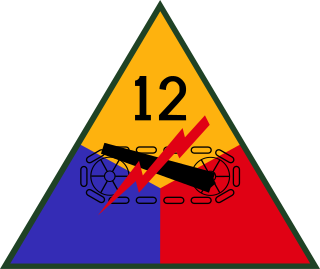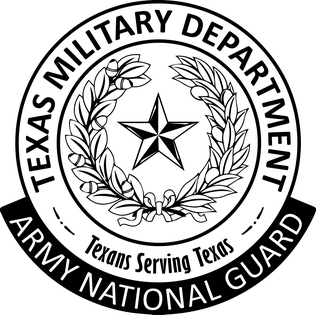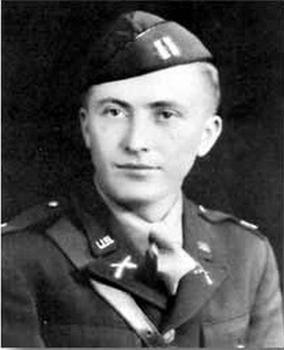
The 36th Infantry Division ("Arrowhead") also known as the "Panther Division", the "Lone Star Division", "The Texas Army", and the "T-patchers", is an infantry division of the U.S. Army and part of the Texas Army National Guard. The 36th Infantry Division was organized during World War I (1914–1918) from units of the Texas National Guard and of the Oklahoma National Guard. As an all-Texas unit, the Arrowhead Division was called to service for World War II (1937–1945) on 25 November 1940, was deployed to the European Theater of Operations in April 1943, and returned to the Texas Army National Guard in December 1945.

The Army National Guard (ARNG), in conjunction with the Air National Guard, is an organized militia force and a federal military reserve force of the United States Army. They are simultaneously part of two different organizations: the ARNG of each state, most territories, and the District of Columbia, as well as the federal ARNG, as part of the National Guard as a whole. It is divided into subordinate units stationed in each state or insular area, responsible to their respective governors or other head-of-government.

The 12th Armored Division was an armored division of the United States Army in World War II. It fought in the European Theater of Operations in France, Germany and Austria, between November 1944 and May 1945.

The 442nd Infantry Regiment was an infantry regiment of the United States Army. The regiment including the 100th Infantry Battalion is best known as the most decorated in U.S. military history, and as a fighting unit composed almost entirely of second-generation American soldiers of Japanese ancestry (Nisei) who fought in World War II. Beginning in 1944, the regiment fought primarily in the European Theatre, in particular Italy, southern France, and Germany. The 442nd Regimental Combat Team (RCT) was organized on March 23, 1943, in response to the War Department's call for volunteers to form the segregated Japanese American army combat unit. More than 12,000 Nisei volunteers answered the call. Ultimately 2,686 from Hawaii and 1,500 from mainland U.S. internment camps assembled at Camp Shelby, Mississippi in April 1943 for a year of infantry training. Many of the soldiers from the continental U.S. had families in internment camps while they fought abroad. Meaning to risk everything in order to win, the unit's motto was "Go For Broke". Before they left Mississippi, the 100th was given permission to use the slogan it wanted, "Go For Broke," the crapshooters' cry to "shoot the works."

The 50th Armored Division was a division of the Army National Guard from July 1946 until 1993.

The Texas Army National Guard is a component of the United States Army, the United States National Guard and the Texas Military Forces.
The Texas Military Forces (TXMF) are the principal instrument through which the Texas Military Department (TMD) executes security policy for Texas, which has the second-largest population and border in the United States.

Captain Henry Thomas Waskow was a United States Army officer, with the rank of captain, memorialized in Ernie Pyle's dispatch "The Death of Captain Waskow," which in turn was faithfully portrayed in the movie The Story of G.I. Joe. The column also publicized the documentary film The Battle of San Pietro, by John Huston, depicting the action in which Waskow died.
The 141st Infantry Regiment is an infantry regiment in the United States Army. The lineage of the 141st includes units tracing origins to the Texas Revolution, such as Company A, First Texas, 1836, and other infantry companies of the First Texas formed in the 1870s and 1880s.

The 143rd Infantry Regiment is an airborne infantry formation in the Army National Guard and has one battalion active under the Texas Army National Guard.
Confederate monuments and memorials in the United States include public displays and symbols of the Confederate States of America (CSA), Confederate leaders, or Confederate soldiers of the American Civil War. Many monuments and memorials have been or will be removed under great controversy. Part of the commemoration of the American Civil War, these symbols include monuments and statues, flags, holidays and other observances, and the names of schools, roads, parks, bridges, buildings, counties, cities, lakes, dams, military bases, and other public structures. In a December 2018 special report, Smithsonian Magazine stated, "over the past ten years, taxpayers have directed at least $40 million to Confederate monuments—statues, homes, parks, museums, libraries, and cemeteries—and to Confederate heritage organizations."

The 133rd Field Artillery Regiment is a parent field artillery regiment of the United States Army National Guard. It is currently represented in the Texas Army National Guard by the 1st, 3rd, and 4th Battalions.

Clayton P. Kerr was a major general in the United States Army. A longtime member of the Texas Army National Guard, he was prominent for his service as deputy commander of the Allied Military Mission to the Italian Army during World War II, and his post-war assignments as commander of the 49th Armored Division and Director of the Army National Guard.

The military career of Audie Murphy encompassed two separate careers. His U. S. Army service covered nine World War II campaigns fought by the 3rd Infantry Division: Tunisia, Sicily, Naples-Foggia, Anzio, Rome-Arno, Southern France, Ardennes-Alsace, Rhineland and Central Europe. He lied about his age to enlist in the United States Army in 1942. Before his 20th birthday he had earned every Army combat award for valor available during his period of service and had risen to the rank of first lieutenant. On the day he was awarded the Medal of Honor for his January 1945 actions at the Colmar Pocket in France, he was considered to be America's most decorated World War II soldier and received national recognition as such when Life magazine made him their cover story. He has been described as the most highly decorated soldier in U.S. history.

The Texas Military Forces Museum is a history museum in Austin, Texas. It is hosted by the Texas Military Department at Camp Mabry and is part of the United States Army Historical Program.

The 36th Airborne Brigade was an airborne brigade of the United States Army and the Texas Army National Guard. The brigade was active from 1 November 1973 to 1 April 1980. The unit's lineage continues today in the 36th Infantry Division.

The 144th Infantry Regiment is an infantry regiment of the United States Army, Texas Army National Guard. It was formed in 1880 and served in several American wars including the present War on Terror. Currently, only the 3rd Battalion remains, and it is a part of the 56th Infantry Brigade Combat Team of the 36th Infantry Division.

The Disabled American Veterans of Texas Monument is an outdoor memorial commemorating Texan veterans who were disabled while serving in the United States military services, installed on the Texas State Capitol grounds in Austin, Texas, in 1980. The monument's base is made from Texas Sunset Red Granite, and features inscriptions and the bronze seal of the Disabled American Veterans.
















